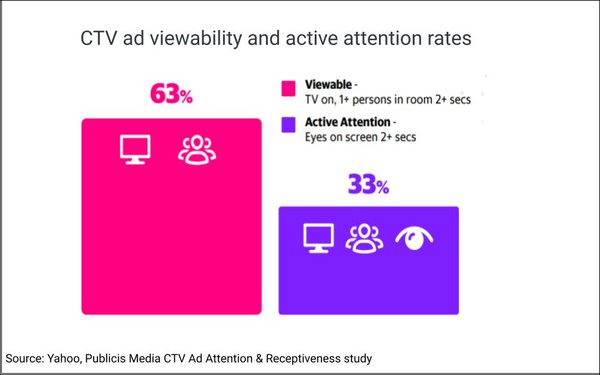
While streaming viewers are
generally accepting of ads, just a third of connected TV (CTV) ads receive two or more seconds of active, eyes-on-the-screen attention, according to a study from Yahoo and Publicis Media that used
both facial recognition and ACR data and a consumer survey to probe CTV ad attention and receptiveness.
The study also found that viewers tend to pay more attention to ads on apps that are
paid or subscription-based — particularly virtual, multichannel programming distributors (MVPDs) like YouTube, Fubo and Sling TV and hybrids like Hulu, HBO Max and Paramount+ — where there
is more intent behind programming choices.

However, some FASTs do generate high ad attention rates. In fact, Xumo outperforms all of its paid counterparts, and the Roku Channel is in the top five.
advertisement
advertisement

Viewers also said they expect a better ad experience and are more
critical of ads on paid streamers. “When you’re watching a commercial on a [paid] channel… it’s not supposed to be humdrum television,” said one.
Advertising
attention increases with age. Younger CTV viewers are harder to engage.
But it’s possible to use streamer type to help target viewers. Those under 18 are nearly 50% more likely to spend
time with hybrid apps and those between 18 and 29 are nearly 60% more likely to watch these apps. Smart TV channels on FAST platforms are most popular among those 40 to 49, and standalone FASTs among
those 50 to 60-plus.


The paid subscription formats’ average edge in ad
attention may in part have to do with the ad experience. Two-thirds of viewers said their worst ad experiences include ads that cut off a show at an unnatural juncture (e.g. mid-sentence), 61% cited
ads that cut a show off at a cliffhanger, and 47% cited ad breaks that are not evenly spaced throughout a show.
More than half said the cable ad experience is more predictable than that of
streaming services, and that they’d like streaming ads to be more similar to cable.
No streaming format got high marks, but 43% of viewers agreed that the ad experience feels
“natural” on vMVPDs, versus 39% saying the same about hybrids, 38% about smart TV FAST channels, and just 33% about FASTs.

Still, nearly half (46%) of CTV viewers said they would rather pay less and receive
some ads when adding a new streaming service, 82% expect ads on free streaming services, and seven out of 10 report being at least somewhat satisfied with their CTV ad experiences. In addition, 56%
agreed that ads and commercials provide them with useful information.
However, just 63% of all CTV ads were found to be viewable (TV on, one or more person in the room, and on screen for two
or more seconds), and just a third of those drew eyes-on-screen attention for two seconds or more.
Half said they frequently have TV on in the background/do other things while watching TV (60%
of women, 47% of men), and 44% of FAST viewers said they frequently leave the TV on all day.
The researchers used TVision facial recognition and ACR data to capture attention metrics,
analyzing 66,000 ads, 1.3 million impressions, 5,000 households, and 15,000 individuals in 25 DMAs across four CTV ad environments. These included paid subscription-based services that were either
hybrid (Hulu, HBO Max, Paramount+, Peacock, Discovery+, Disney+, Netflix, Amazon Prime Video) or vMVPD (Fubo, YouTubeTV, Sling, Philo, DirecTV Stream); and non-subscription-based streaming apps that
were either standalone free, ad-supported FASTs (Tubi, Pluto, Roku, Crackle, Vudu, Xumo) or smart TV FAST channels (Amazon Freevee, Vizio’s WatchFree, Samsung TV Plus, LG Channels). The study
also included a survey of 1,000 adult CTV consumers done by Open Mind Strategy.